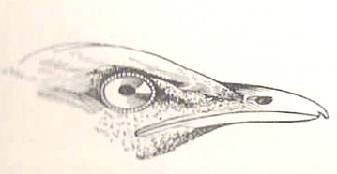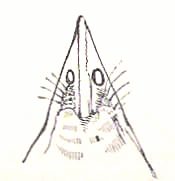
Bell Bird (Chasmorhynchus Nudicollis)

Beak of Bellbird (Chasmorhynchus Nudicollis)
|
Waterton in his book "Wanderings,
2nd Journey"
wrote that this bird is approximately the same size as a jay, with snowy
white plumage. He noted a spiral tube of almost 3 inches in length
rising from the bird's head, this being black and dotted over with small
white-colored feathers. Waterton continued that this tube was able
to reach the bird's mouth, and appeared like a spire when filled with air,
yet looked pendulous when "empty". However, Mr Salvin recorded his
impression in Ibis, 1865, page. 93, that "no inflation takes place,
and that the bird possesses little or no voluntary muscular control over
these excrescences" in an allied species from Costa Rica, referred to at
that time as Chasmorhynchus tricarunculatus - so called from
its three elongated appendages, which in appearance call to mind the long
pendants of an orchid (Cypripedium caudatum).
The fact that a Brazilian species, referred to
by 19th century ornithologits as Chasmorhynchus nudicollis,
was
said to utter a note which, if not actually "bell-like" in tone, had a
clear metallic ring, though the bird, as may be seen by the picture, has
no caruncle, shows that this feature is not likely to be connected with
the power of producing the peculiar sound. A fourth species, referred
to as Chasmorhynchus variegatus, was said to inhabit Trinidad and
the neighboring part of South America. Its loud note was likened
by Leotaud (Ois Trinidad, P. 260) to the sound of a cracked
bell. Its call was described as being loud and clear, like the sound
of a bell, and apparently could be heard from three miles away. The
bird was said to toll, pause for a minute then toll again and pause once
more. These minute long pauses would continue for three times before
a longer six to eight minute pause, after which the tolling would continue
at one minute spaces for another three times.
|





